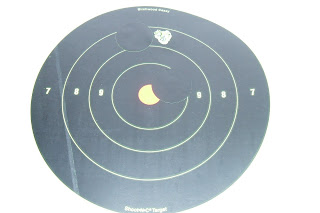
3/8 inch 3 shot group 100 yards with Federal 130 Grain Hi Shok Factory Load


200 yards on paper plate target with 150 grain round nose
“Jack O’Connor’s Beloved .270 Win”
The .270 Win was developed by Winchester Arms Co. in 1923 and had its debut in 1925 in Winchester’s, bolt action mdl 54. It has been in continuous production since that date. I am not talking about the Mdl 54 rifle itself, but of course the .270 Win cartridge. The round started out with a 130 grain bullet at around 3140 fps and was later reduced to around 3060fps. Later a 100 grain varmint load was added and a 150 grain load for game up to and including moose. Over the years, the .270 has been offered in single shots, lever actions, bolt actions, pumps, semi-autos and rare double rifles. It has been offered in bullet weights from 90 to 180 grains for handloaders. Factory loads have included, 100, 130, 140, 150 and 165 grain weights. Most popular have been the 130-150 grain loads. One of the newest loads is the Winchester XP3 load in 130 grain weight. Per Winchester specs, this load has a MV of 3050fps, and ME of 2685 foot pounds and drops just 6.5 inches at 300 yards when sighted dead on at 200 yards.
When I was a kid growing up, I used to pour over the various ballistics tables and memorized the data for several factory cartridges. I also read much of what was in print at the time from both Jack O’Connor and Elmer Keith. They were from different schools of thought on killing power, I.E. “small bore/high velocity rounds” (vs.) “big bore, heavier bullets”. Elmer of course was from the big slow moving bullet school of thought and once in print indicated, “The .270 Win was a damned adequate coyote rifle”. The debate went on for years between these two talented gentlemen, however I always felt there was room for both schools of thought.
I own a .270, which of course was Jack’s rifle of choice in large part and I also own a .338 Federal, and a 45-70 which falls on the Elmer Keith side of the fence. I also own a .35 Remington, which from a bore size perspective is on Elmer’s list but would fall short in the energy department.
The .270 Win is by the way, if my sources are correct, the second most popular caliber coming in right behind the 30:06 in terms of ammunition sales. O’Connor was also very fond of the 30:06 and used it quite a bit. The 2007 edition of Cabela’s shooting catalog list no less than 21 different factory loads for the .270 from six different manufacturers. Cartridges come and go, however the .270 has stood the test of time since 1925.
My .270 is a Ruger 77/MKII with a synthetic stock and stainless bbl and action. This gun has been a backup on several hunts and yet I have never taken a big game animal with it. It has been with me to Maine several times and also went to Saskatchewan on a whitetail hunt and to Canada on a moose hunt. I owned another Ruger mdl 77/MKII at the time in .300 Win mag and since that gun never failed me, the .270 stayed in camp. I no longer own, the .300 mag (regrettably so), and perhaps the .270 will become the rifle of choice on some future hunts.
Mine wears a Simmons Aetec 2.8X10X44 (1st generation scope and not the newer Master series). The rifle has always shot both 130 grain and, 150 grain loads well. I once shot a 1.25”, 200 yard group with this gun using Federal 130 grain hydrashok loads. That particular bullet is no longer made by Federal, and it is now sighted in with Winchester 150 grain power points. The Winchester’s recently produced a 100 yard ¾” 3 shot group center to center. Remington 150 grain core lokts produced a 1.25”, center to center 3 shot group at essentially the same point of impact and Federal 150 grain Fusion load went into 2.5” for a 3 shot group. I left out the 140 grain loads for a reason, as my particular rifle will simply not shoot them well. If your rifles does, then the 140 grain load is a good compromise between the 130 and 150 grain loads.
The .270 has a bad rap in some circles from an accuracy standpoint and for that matter, so does the Ruger. Personally I have NOT found that to be the case. In fact, the Ruger MKII in .270 has proven to be one of the most consistently accurate rifles in my safe. I did have a trigger jog done on it by Allen Timney in Cerritos, CA when the rifle was new, which contributes in the accuracy dept. Other than that modification, the gun is the same as it left the factory. I have always admired the Ruger integral ring set up as one of the most rugged in the industry.
If your pursuit is long range deer in the Midwest, whitetails in the Maine woods, or black bear over bait, you can’t go wrong with a .270 Win in your hands.
Dan 10/11/2007
www.deer-hunting-information.com
Proverbs 22:2 KJV "The rich and poor meet together; the Lord is the maker of them all"

No comments:
Post a Comment